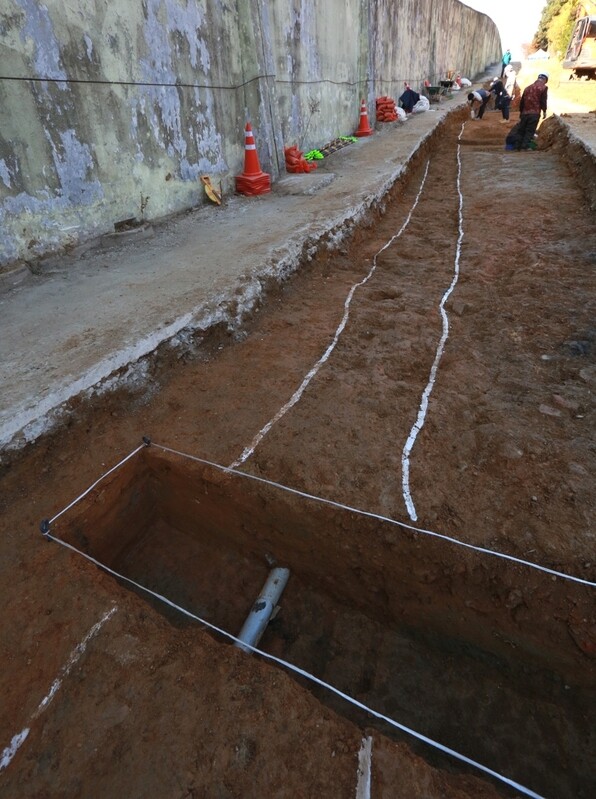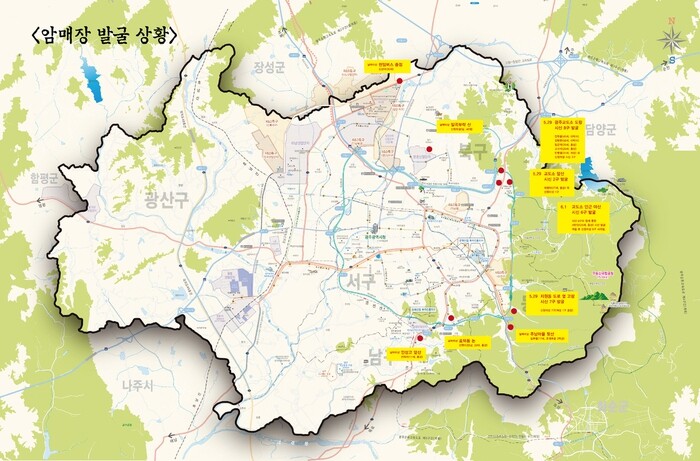hankyoreh
Links to other country sites 다른 나라 사이트 링크
Victims of 1980 Gwangju Uprising buried secretly during the night, witness says

“They were dragging the loaded cart in front and I was pushing it from behind, and the legs of the bodies we had tied up were bouncing up and down.”
This was part of the detailed account that a 60-year-old individual surnamed Yu, who had been a sergeant with the 3rd Airborne Brigade, provided of the horrific burial in the middle of the night of nine protesters who died of suffocation during the Gwangju Uprising (May 18, 1980). On May 11, Yu met The Hankyoreh at a café near the KTX train station in Gwangmyeong, Gyeonggi Province, and explained that he had been given the burial duty at Gwangju Prison on the evening of May 21, 1980.
The 3rd Airborne Brigade, of which Yu was a part, had arrived at Gwangju on the morning of May 20. That was after the 11th Airborne Brigade had been deployed to support the 7th Airborne Brigade. “At morning roll call on May 19, an emergency bugle was sounded,” Yu recalled.
Yu saw his first corpses after arriving at Chonnam National University, where the brigade was stationed. “There was one guy whose eye had popped out [from a beating]. A couple of soldiers were loading bodies into gunnysacks and dragging them off to a hill nearby,” he said.
The crackdown on the protesters began that evening. Even though Yu had an administrative job in the personnel division at headquarters, he was ordered to head out to the street. As he held his firearm in a ceremonial position – barrel up, pointed to the right – he watched as his superiors, staff sergeants and sergeants first class, broke up the protest.
”Gwangju was filled with the smell of blood”

“Some soldiers were throwing tear gas grenades and others were wielding batons,” Yu said. Soldiers with the 3rd Airborne Brigade rounded up more than 200 protesters (120, according to the military’s situation log), loaded them into vehicles, and took them to Chonnam National University.
“Gwangju was filled with the smell of blood,” Yu said.
On the morning of May 21, each of the soldiers was given 30 live rounds. Around lunch, the 3rd Airborne Brigade changed its base to the old Gwangju Prison (in the Gakhwa Neighborhood). Six or seven vehicles were used to transport around 30 or 40 protesters each. After the soldiers reached the prison and pitched the tent for their headquarters, they let their prisoners out of the vehicles and into the yard. But during the ride over, nine of them had died.
“One of the vehicles was a broadcasting van without any windows, and there probably wasn’t enough air for them to breathe. Even so, people were shoved into that van,” Yu said.
A dozen or so people were put to work on the secret burial. “All right, senior sergeants, there’s no one to deal with the folks who just died if you don’t. You’ve hit the jackpot,” Yu quoted his first sergeant as saying.
The soldiers prepared the bodies for burial by wrapping them in straw sacks and tying them up with strings. Around 8 or 9 in the evening, they loaded the bodies into a cart, two at a time, and moved them to a field between the prison inner and outer walls. Some soldiers were digging a hole over there. “We buried six bodies in three holes and the remaining three bodies in one hole,” Yu said.
Last year, Yu called the May 18 Memorial Foundation and opened up about the experience he had long kept secret. As it happened, Gwangju Prison had already been identified as a likely site of a secret burial. In the results of its inquiry into the Gwangju Uprising on May 31, 1980, the martial law command stated that 28 people had died “around the prison.” But identities were confirmed for only 11 of those who died here, leaving 17 unidentified until this day.
Claims about a secret burial have been made by various people, including Shin Sun-yong, a major with the 11th Battalion of the 3rd Airborne Brigade; a staff sergeant surnamed Kim with the 15th Battalion; and two people detained at the prison at the time. Based on these testimonies – as well as a map that a major surnamed Kim who was HQ commander for the 3rd Airborne Brigade drew for the prosecutors on May 29, 1995, when he told them that 12 bodies had been buried in the prison – the May 18 Memorial Foundation launched an excavation on Nov. 2017 but failed to find the burial site despite two months of digging.
Burial site now a sewage treatment plant
Yu revisited the scene of the burial at the Gwangju Prison on Nov. 23, 2017, 37 years after it happened.
“A sewage treatment plant went up where I buried the bodies. That’s a real shame, since the bodies may have been disposed of in the process,” he said.
“The sight of a garlic stem is enough to remind me of the uprising. Garlic stems were one of the common side dishes then served in Gwangju. I hope more witnesses speak up so we can learn the truth about the secret burial,” Yu said.
By Jung Dae-ha, Gwangju correspondent
Please direct comments or questions to [english@hani.co.kr]

Editorial・opinion
![[Column] Season 2 of special prosecutor probe may be coming to Korea soon [Column] Season 2 of special prosecutor probe may be coming to Korea soon](https://flexible.img.hani.co.kr/flexible/normal/500/300/imgdb/original/2024/0426/3317141030699447.jpg) [Column] Season 2 of special prosecutor probe may be coming to Korea soon
[Column] Season 2 of special prosecutor probe may be coming to Korea soon![[Column] Park Geun-hye déjà vu in Yoon Suk-yeol [Column] Park Geun-hye déjà vu in Yoon Suk-yeol](https://flexible.img.hani.co.kr/flexible/normal/500/300/imgdb/original/2024/0424/651713945113788.jpg) [Column] Park Geun-hye déjà vu in Yoon Suk-yeol
[Column] Park Geun-hye déjà vu in Yoon Suk-yeol- [Editorial] New weight of N. Korea’s nuclear threats makes dialogue all the more urgent
- [Guest essay] The real reason Korea’s new right wants to dub Rhee a founding father
- [Column] ‘Choson’: Is it time we start referring to N. Korea in its own terms?
- [Editorial] Japan’s rewriting of history with Korea has gone too far
- [Column] The president’s questionable capacity for dialogue
- [Column] Are chaebol firms just pizza pies for families to divvy up as they please?
- [Column] Has Korea, too, crossed the Rubicon on China?
- [Correspondent’s column] In Japan’s alliance with US, echoes of its past alliances with UK
Most viewed articles
- 1Samsung subcontractor worker commits suicide from work stress
- 2‘We must say no’: Seoul defense chief on Korean, USFK involvement in hypothetical Taiwan crisis
- 3[Editorial] Korea’s surprise Q1 growth requires objective assessment, not blind fanfare
- 4No good, very bad game for Korea puts it out of Olympics for first time since 1988
- 5Division commander ordered troops to enter raging flood waters before Marine died, survivor says
- 6N. Korean delegation’s trip to Iran shows how Pyongyang is leveraging ties with Moscow
- 7Korea’s 1.3% growth in Q1 signals ‘textbook’ return to growth, says government
- 8US overtakes China as Korea’s top export market, prompting trade sanction jitters
- 9[Column] Park Geun-hye déjà vu in Yoon Suk-yeol
- 10[Column] Season 2 of special prosecutor probe may be coming to Korea soon